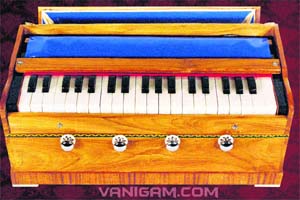|
The soul of music
The harmonium is
part of many households. It is required in temples and gurdwaras.
No music director can compose tunes without this instrument,
says Shekher
Phadnis
|

The harmonium is used to accompany bhajans, folk music, ghazals, light Hindi songs and qawaalis
|
THE harmonium has
long been a favourite with musicians, including the wandering
minstrels who sling it on their backs. For learning the
fundamentals of music, the harmonium is absolutely essential
and, in fact, it is part of many households in India. It is
required in temples and gurdwaras as an accompaniment for
singing bhajans and kirtans. It is essential for tamasha
and folk music and also for touring musical troupes in rural
areas. No music director can compose without the ubiquitous
harmonium. The harmonium also forms an integral part of the qawwali
repertoire, as many qawwals use the instrument while
performing.
The harmonium was
introduced to India by missionaries in the mid 19th
century, and though the design remains, it boasts of some Indian
innovations like "drone stops" and a scale-changing
mechanism. It might surprise the music lovers to know that the
harmonium was invented by Parisian Alexandre Debain in 1842. May
be because of its French origin, that the Indian government
still considers the harmonium a foreign instrument. Though it is
made in India now, the government still treats it at par with
the guitar, violin or piano and levies VAT of 12.5 per cent on
it. The least priced harmonium costs Rs 8,000.
But musically
speaking, the harmonium is essentially an alien instrument to
the Indian tradition, as it cannot mimic the voice, which is
considered the basis of all Indian music. Meend
(glissando), an integral part of any classical recitation, is
not possible on the harmonium, and as such, one cannot
faithfully reproduce the subtle nuances of a raga on this
instrument. The harmonium is thus despised by many connoisseurs
of Indian music.
Purists in Indian
music opine that the harmonium, the piano and the
electronic keyboard, with 12 keys to an octave, cannot capture
any of the microtones that Indian music is famous for, and it
would be necessary to design a harmonium with 22 keys in an
octave so that it can it can handle all the nuances of Indian
music.
Samvadini, a
modified version of harmonium, is often used by Indian harmonium
maestros to perform solo on the instrument.
The harmonium is
used to accompany bhajans, folk music, ghazals, Hindi
light songs, qawaalis, kirtan, Shabads, classical and
semi-classical forms of Indian music.
But in the
Carnatic music, the classical music of South India, harmonium’s
use is very much limited. Music maestros like Devudu Iyer
and Madurai M.R. Vasavambal helped to establish a place for the
harmonium in Carnatic music, but their careers were restricted
to the drama stage. As per septuagenarian Carnatic musician
Palladam Venkataramana Rao: "People do not take up the
harmonium because it is not possible to produce the gamaka
(subtle variations in the pitch of a note, that produces a kind
of ‘shaking' of the notes) on it. But gamaka alone does not
constitute Carnatic music," says Rao, who is perhaps the
only artiste who gives solo harmonium Carnatic music concerts.
All India Radio banned the use of harmonium by classical
artistes from 1940 to 1971 for the same reason. "The ban on
solo performance was lifted only recently," says V
Ramnarayan, editor of the Sruti magazine, a journal
devoted to Indian music. The violin slowly slipped into the
place that the harmonium had vacated as an accompaniment in
concerts. Musicians also found that the violin could reproduce
the concert-embellishing gamakas that the harmonium could not.
But harmonium
proved to be a great success with eminent Hindustani musicians
like Gyan Prakash Ghosh, Appa Jalgaonkar, Ustad Zamir Ahmed
Khan, Ustad Bhure Khan, and in Carnatic music, Perur Subrahmania
Dikshitar and Alathur Venkatesa Iyer were outstanding harmonium vidwans,
who played nothing but Carnatic music on the keyboard
instrument.
The invention of
the electronic organ in the mid 1930s spelt the end of the
harmonium's success (although its popularity as a household
instrument declined in the 1940s as musical tastes changed).
Teakwood is mainly
used for making harmoniums. "We make harmoniums with
single, double, triple reeds where the same key would produce
different tones. We specialise in instruments with four set of
reeds," says Elangovan of Madras Music Emporium at Chennai..
Various persons are involved in woodwork and assembling the
instrument in his shop. Unlike instruments such as the veena and
guitar, where the tuning is done by the users, harmoniums have
to be tuned as they are being made. "Business has become
dull over the years as many people prefer keyboard over
harmoniums," says Elangovan. Benares, Pune and Kolkata are
other important harmonium-making centres. — MF
|